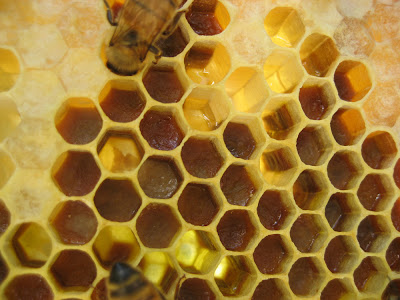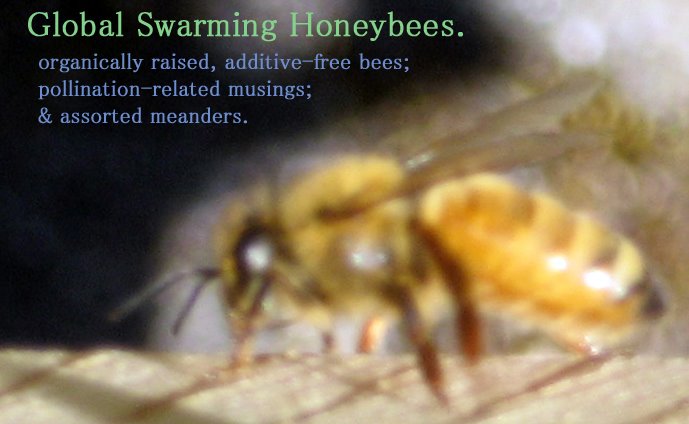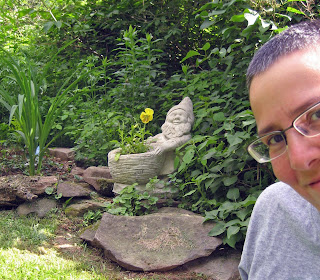Two weeks ago, I paid a visit to the bee yard to confirm that the (previously) virgin queens had mated and were laying "the next generation" in Hive Orange and Green Hive, both of which swarmed on June 21, taking with them the old queens and leaving newly raised, virgin queens behind. I was pleased to find plenty of evidence that all was well, reproduction-wise, in both hives. Here's a quick tour of what I found. (Click the photos to view them in a larger format.)
 In these two combs, you see just what a beekeeper hopes to find: plenty of capped worker brood—the cells covered by the tan-colored, porous-looking caps in the middle of the comb. Notice that these capped cells form a nice pattern filling in the majority of cells in the the comb. This is suggestive of a good queen who has laid each of her eggs in a efficient pattern along the comb. Bordering the top of the comb, the bees store nectar (note the pale or yellowish uncapped cells) and capped honey (whitish caps).
In these two combs, you see just what a beekeeper hopes to find: plenty of capped worker brood—the cells covered by the tan-colored, porous-looking caps in the middle of the comb. Notice that these capped cells form a nice pattern filling in the majority of cells in the the comb. This is suggestive of a good queen who has laid each of her eggs in a efficient pattern along the comb. Bordering the top of the comb, the bees store nectar (note the pale or yellowish uncapped cells) and capped honey (whitish caps).
Below that are some dark, uncapped cells in which pollen is being stored. Both food sources—honey for carbs, pollen for protein—are conveniently located above the brood cells to make it easier for the nurse bees to mix "bee bread" (pollen + nectar/honey) to feed the larvae numerous times a day over a period of several days. During this time, the larvae grow at a rapid rate. Once they are ready to morph into the winged creature we know as the honeybee, the cell is capped and the magical rearrangement of the bee's molecular biology begins.  Here you see larvae being fed and attended to by nurse bees. You also see some capped cells inside of which are larvae undergoing metamorphosis.
Here you see larvae being fed and attended to by nurse bees. You also see some capped cells inside of which are larvae undergoing metamorphosis. Once the bees have built out enough combs for a nice, big broodnest, they start building honeycombs—combs with larger cells for storing honey and pollen that will be used during times of dearth and, of course, during wintertime when nothing's blooming and it's too cold for the bees to fly. The dark cells in this lovely bee-composition contain pollen. Along the top and upper-middle right is capped honey. There are also some as-yet empty cells and cells containing uncapped nectar.
Once the bees have built out enough combs for a nice, big broodnest, they start building honeycombs—combs with larger cells for storing honey and pollen that will be used during times of dearth and, of course, during wintertime when nothing's blooming and it's too cold for the bees to fly. The dark cells in this lovely bee-composition contain pollen. Along the top and upper-middle right is capped honey. There are also some as-yet empty cells and cells containing uncapped nectar.
After the bees bring nectar into the hive and deposit it in the cells, it takes some time (and effort on the bees' part—mainly through the fanning of their wings) to reduce the moisture level to the point where it becomes honey. Once it does, the bees cap the cell with wax, keeping the precious substance clean and protected for future use. As William Longgood observes in his great book The Queen Must Die, "To the bee, honey is the ultimate reality." Here's a closeup of the pollen, capped honey, and open cells. By the way, the pollen colors vary enormously as different plants come into bloom and are visited by the bees. I can't be sure, but I suspect this pollen is from white clover.
Here's a closeup of the pollen, capped honey, and open cells. By the way, the pollen colors vary enormously as different plants come into bloom and are visited by the bees. I can't be sure, but I suspect this pollen is from white clover.
When I look at a closeup like this—and every time I visit the hive and watch how hard the bees are working—I can't help but think about how many dozens of trips by dozens of bees it takes to fill a single cell with honey or pollen. Truly, every teaspoon of honey and every grain of pollen represents a herculean effort on the part of the honeybees. And that's leaving aside the genius of the comb itself...
And that's leaving aside the genius of the comb itself...

8.06.2007
A Tour of the Hive
Subscribe to:
Post Comments (Atom)






1 comment:
Great photos... inspiring really. Bees are such amazing creatures!!!!!
Post a Comment